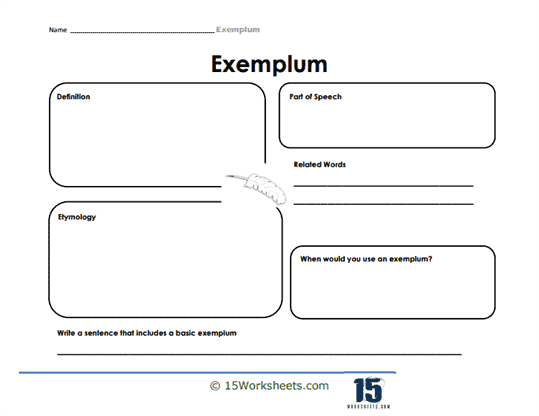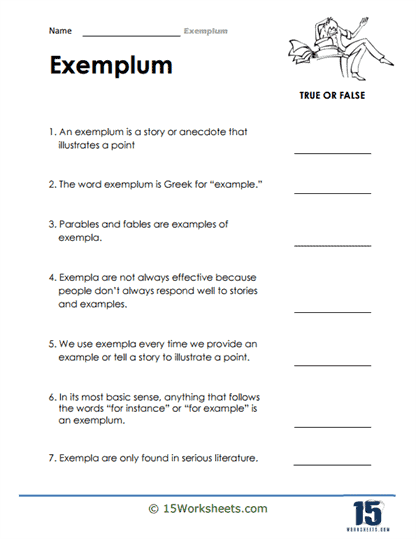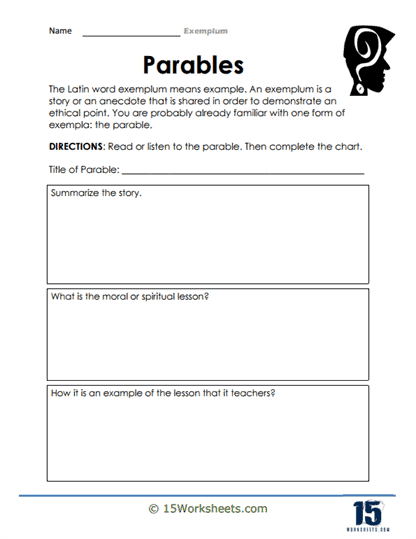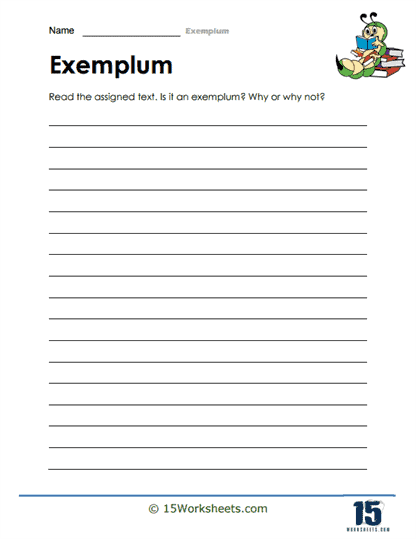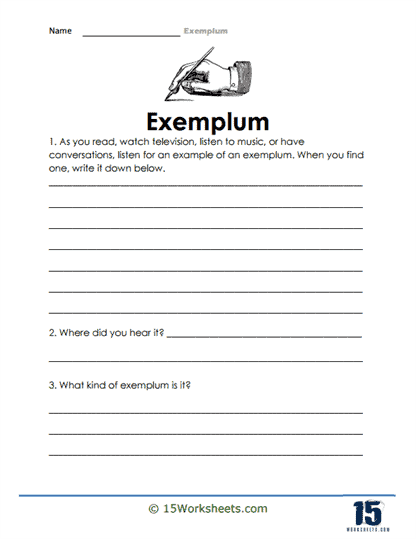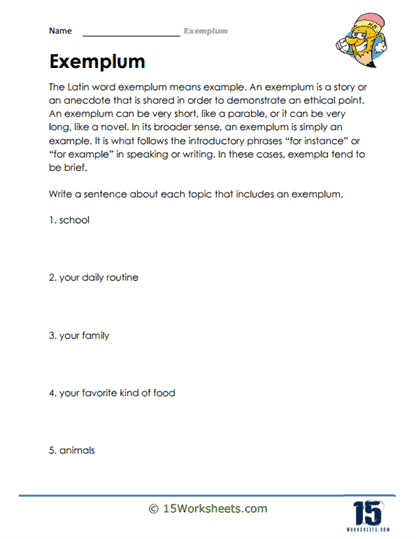Exemplum Worksheets
About These 15 Worksheets
These worksheets will help deepen students’ understanding of exempla, a rhetorical device or narrative technique that uses examples or anecdotes to illustrate a moral or thematic point. These worksheets engage students in the analysis and creation of exempla, enhancing their critical thinking, comprehension, and narrative skills. Exemplum, traditionally used in medieval sermons and moral teachings, has found its place in modern literature, speeches, and everyday discourse, making the understanding of this device vital for students studying language arts.
Through the study and practice of exempla, students not only enhance their understanding of narrative techniques and their functions but also develop a deeper appreciation for the power of storytelling in shaping ideas, morals, and societal values. Engaging with these worksheets prepares students for a range of academic and real-world challenges, equipping them with the tools to analyze, argue, and articulate their ideas with clarity and conviction.
Types of Exercises
Identification – Students are presented with texts or excerpts and are tasked with identifying the exempla within them. This basic exercise helps students recognize how examples are used to support or illustrate arguments, themes, or moral lessons.
Analysis – Beyond identification, students analyze the purpose and effectiveness of the exempla. They consider questions like – How does the exemplum support the argument or theme? What emotions or responses does it evoke? This type of exercise encourages students to think critically about the use of narrative in persuasion and teaching.
Comparisons – These exercises involve comparing and contrasting exempla from different texts, cultures, or historical periods. Students evaluate how the context influences the choice of exempla and the values or lessons they are meant to convey. This comparative analysis broadens students’ understanding of cultural and historical perspectives.
Creation Exercises – Students apply their knowledge by creating their own exempla based on given themes, morals, or arguments. This encourages creativity and helps students practice constructing effective narratives that can support a point or moral lesson.
Integration Exercises – In these exercises, students integrate exempla into essays, speeches, or other forms of writing. They learn how to effectively use narrative examples to support their points, enhancing their persuasive and expository writing skills.
Reflection – Students reflect on the exempla they’ve encountered, discussing or writing about the impact of these narratives on their understanding of the theme or moral lesson. This fosters personal connection to the material and deepens comprehension.
Discussion – Working in groups or as a class, students discuss the exempla, sharing insights about their effectiveness, emotional impact, and the values they promote. This collaborative exercise encourages verbal articulation of ideas and peer learning.
Research – Students research historical or cultural exempla, exploring their origins, purposes, and the contexts in which they were used. This exercise enhances students’ research skills and their appreciation for the diversity of narrative forms and functions.
The Benefits of These Worksheets
Engaging with exemplum worksheets offers numerous benefits for students’ development in language arts and reading skills:
Enhanced Comprehension – By analyzing and creating exempla, students develop a nuanced understanding of how narratives function to illustrate and reinforce themes or morals. This comprehension aids in the interpretation of a wide range of texts, from fiction to persuasive essays.
Improved Analytical Skills – Analysis and comparison exercises sharpen students’ ability to dissect texts, understand authors’ intentions, and evaluate the effectiveness of narrative techniques. These critical thinking skills are essential for academic success across subjects.
Creative Expression – Creation exercises stimulate students’ imagination and encourage them to experiment with their own narrative voices. Engaging in narrative writing enhances their ability to convey ideas creatively and effectively.
Persuasive Writing Abilities – Learning to integrate exempla into their writing equips students with a powerful tool for persuasion and argumentation. This skill is invaluable in essay writing, debates, and public speaking.
Cultural and Historical Awareness – Research and comparison exercises broaden students’ perspectives by introducing them to exempla from diverse cultures and eras. This fosters a global outlook and a deeper appreciation for the role of narrative in shaping values and beliefs.
Reflection and Personal Connection – Reflective writing and discussion exercises encourage students to connect personally with the material, fostering empathy and a deeper engagement with literature and its themes.
Collaborative Skills – Group discussions and collaborative analysis exercises enhance verbal communication skills and the ability to work effectively in teams. Sharing insights and ideas promotes a collaborative learning environment where students can learn from each other.
Research Skills – Research exercises develop students’ ability to locate, evaluate, and synthesize information from various sources. This skill is crucial for academic research and lifelong learning.
What is the Literary Device of Exemplum?
The literary device of exemplum plays a crucial role in narrative and rhetorical strategies across various forms of literature, from ancient parables to contemporary narratives. An exemplum is essentially a short tale, anecdote, or example embedded within a broader text to illustrate a moral lesson, support an argument, or underscore a theme. This device leverages the power of storytelling to convey complex ideas in a relatable and impactful manner, bridging abstract concepts with concrete examples.
Main Defining Feature of an Exemplum
The main defining feature of an exemplum is its illustrative function – it serves to exemplify or illuminate a particular moral, ethical principle, or idea. Unlike mere examples or illustrations, an exemplum carries a narrative quality-it tells a story or presents a scenario that encapsulates the lesson or argument being conveyed. This narrative aspect makes the exemplum a powerful tool for persuasion and teaching, as it engages the reader’s imagination and emotions, making abstract concepts tangible and memorable.
Characteristics of an Exemplum
Narrative Structure – Exempla typically have a clear narrative structure, with a beginning, middle, and end, that presents a situation, develops it, and resolves it in a way that illustrates the intended moral or lesson.
Moral or Didactic Purpose – The primary purpose of an exemplum is to teach or reinforce a moral lesson or ethical principle. It is inherently didactic, aiming to instruct the reader or listener in some aspect of moral or practical wisdom.
Relatability – Exempla often feature characters, settings, or situations that are relatable to the audience, making the moral lesson more accessible and impactful.
Brevity – While an exemplum is narrative in nature, it is typically concise, distilled to its essence to effectively communicate the lesson without unnecessary detail.
Versatility – Exempla can be found in a wide range of genres, including religious texts, historical writings, fables, and modern literature, showcasing their adaptability to different contexts and purposes.
Examples of Exemplum in Literature
Example 1 – The Parable of the Good Samaritan (The Bible, Luke 10:25-37)
In the Bible, the Parable of the Good Samaritan serves as an exemplum to illustrate the concept of “neighbor” and the Christian ethic of love and compassion. A traveler is beaten and left for dead, and while a priest and a Levite pass by without helping, a Samaritan, considered an outsider, provides aid. The story encapsulates the moral lesson that one’s neighbor is anyone in need, and true righteousness comes from compassion and action, not status or ethnicity. This exemplum is effective because it challenges prevailing social norms and presents a clear, memorable example of the moral principle Jesus wishes to teach.
Example 2 – “The Pardoner’s Tale” (Geoffrey Chaucer’s “The Canterbury Tales”)
“The Pardoner’s Tale” is an exemplum used within a larger narrative to illustrate the theme of greed and its destructive consequences. Three young men set out to kill Death, whom they blame for taking their friend, but their quest leads to mutual betrayal and their own deaths due to their greed for treasure. The tale serves as a moral lesson on the dangers of avarice, underlining the Pardoner’s sermon against greed. This exemplum is particularly potent because it not only conveys the moral lesson but also reflects on the teller, the Pardoner, who admits to his own greed and hypocrisy, adding layers of irony and complexity to the narrative.
Example 3 – “To Kill a Mockingbird” by Harper Lee
In Harper Lee’s “To Kill a Mockingbird,” the story of Boo Radley serves as an exemplum of the dangers of prejudice and the importance of empathy and understanding. Initially, Boo is the subject of fear and superstition among the children; he is an enigmatic figure who represents the unknown. Through the events of the novel, particularly when Boo saves Scout and Jem, the children-and by extension, the reader-learn that understanding and compassion are crucial in overcoming fear and prejudice. Boo Radley’s story exemplifies the novel’s central themes, demonstrating the transformative power of empathy and the complexity of human nature.
The Effect of Exemplum on the Reader
The use of exemplum in literature has a profound effect on readers, enhancing their engagement with the text and deepening their understanding of its themes and moral lessons:
Enhanced Engagement – The narrative nature of exempla draws readers into the story, making abstract concepts or moral lessons more engaging and easier to grasp.
Memorability – By encapsulating lessons in narrative form, exempla make these lessons more memorable. Stories stick with readers longer than abstract concepts or directives.
Empathy and Identification – Exempla often feature characters or situations with which readers can identify, fostering empathy and a deeper emotional connection to the moral or theme being explored.
Critical Thinking – Through the presentation of complex situations or moral dilemmas, exempla encourage readers to think critically about ethical principles, societal norms, and human behavior.
Reflective Insight – By illustrating how abstract principles apply in concrete situations, exempla prompt readers to reflect on their own values, beliefs, and actions in relation to the themes presented.








